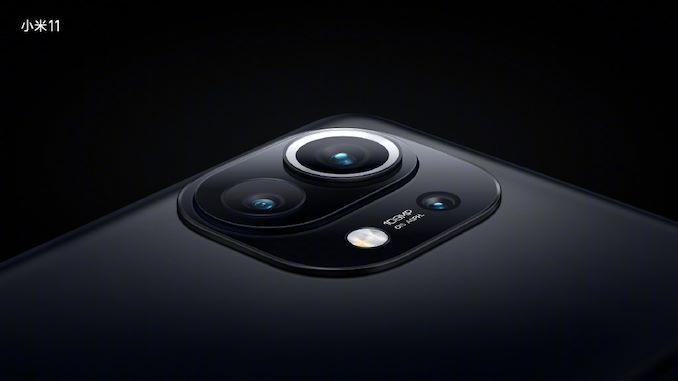Xiaomi Announces the Mi 11: First Snapdragon 888 Device
by Andrei Frumusanu on December 28, 2020 9:30 AM EST- Posted in
- Mobile
- Smartphones
- Xiaomi
- Snapdragon 888
- Mi 11

Today Xiaomi held the Chinese launch announcement of the new Mi 11 – the company’s new mainstream flagship phone for 2021. The new phone features a new super-high-end OLED screen that ticks off every checkmark feature that you’d expect from a 2021 design, including 1440p resolution and 120Hz refresh rates, features the new Snapdragon 888 SoC at its heart – as well as comes in a new thinner, lighter, and more stylish industrial design compared to its predecessors.
| Xiaomi Mi Series | |||
| Mi 10 | Mi 11 | ||
| SoC | Qualcomm Snapdragon 865 1x Cortex-A77 @ 2.84GHz 3x Cortex-A77 @ 2.42GHz 4x Cortex-A55 @ 1.80GHz Adreno 650 @ 587MHz |
Qualcomm Snapdragon 888 1x Cortex-X1 @ 2.84GHz 3x Cortex-A78 @ 2.42GHz 4x Cortex-A55 @ 1.80GHz Adreno 660 @ 747MHz |
|
| DRAM | 8GB LPDDR5-5500 | 8/12GB LPDDR5-6400 | |
| Display | 6.67" AMOLED 2340 x 1080 (19.5:9) 90Hz Refresh |
6.81" AMOLED 3200 x 1440 120Hz Refresh 480Hz Touch HDR10+ / 10-bit panel |
|
| Size | Height | 162.58mm | 164.3mm |
| Width | 74.80mm | 74.6mm | |
| Depth | 8.96mm | 8.06mm | |
| Weight | 208g | 196g | |
| Battery Capacity | 4780mAh (Typical) 30W Charging |
4600mAh (Typical) 55W Charging |
|
| Wireless Charging | 30W | 50W | |
| Rear Cameras | |||
| Main | 108MP 1/1.3" 0.8µm 4:1 Binning to 27MP / 1.6µm f/1.69 w/ OIS |
108MP Module f/1.85 w/OIS |
|
| Telephoto | - | 5MP 50mm eq. f/2.2 |
|
| Extra Telephoto |
- | - | |
| Ultra-Wide | 13MP 1.12µm f/2.4 117° FoV |
13MP f/2.4 123° FoV |
|
| Extra | 2MP Depth Camera 2MP Macro Camera |
- | |
| Front Camera | 20MP 0.8µm f/2.3 |
f/2.2 | |
| Storage | 128 / 256GB UFS 3.0 |
128 / 256GB | |
| I/O | USB-C | ||
| Wireless (local) | 802.11ax (Wifi 6), Bluetooth 5.1 |
||
| Cellular | 4G + 5G NR NSA+SA Sub-6GHz | ||
| Special Features | Under-screen fingerprint sensor Full-range stereo speakers |
||
| Splash, Water, Dust Resistance | No rating | ||
| Dual-SIM | 2x nano-SIM | ||
| Launch OS | Android 10 w/ MIUI | Android 11 w/ MIUI | |
| Launch Price | 8+128GB: 799€ 8+256GB: 899€ |
? | |
At the heart of the new Mi 11 lies the new Qualcomm Snapdragon 888 SoC. The new 5nm chip is the first to use Arm’s new Cortex-X1 cores, with Qualcomm also claiming large GPU performance boosts this generation. What’s more different from the previous Snapdragon 865 flagship design is that the new S888 reverts back to a monolithic SoC design that integrates the 5G modem back into the SoC – in turn this means that there’s more PCB component space in available inside the phone and vendors can optimise their designs better.
The new Mi 11 also features either 8GB or 12GB of the new LPDDR5 memory at its full 3200MHz speed (6400MT/s), and comes in either 128GB or 256GB storage variants, although we’re missing details on the specifications of the modules used here.
In terms of design, the new Mi 11 is quite a departure from the Mi 10, being a much sleeker device than its predecessor. Xiaomi has been able to reduce the bezels of the device on all sides, still using a curved front and back glass design that fits well into your palms. The new design is actually 0.9mm thinner than its predecessor, now coming in at 8.06mm, and also shaves 12g off its weight at 196g – still relatively heavy, but not as much as its predecessor.
The most exciting feature of the Mi 11 has to be the new OLED screen. It’s grown a bit compared to its predecessor, filling in the space in place of the bezels, going from 6.67” to 6.81”, but the most important aspect of the phone is the fact that this is now a QHD class resolution at 3200 x 1440 – a first from Xiaomi OLED screen and a resolution we haven’t seen used by the company since back in the LCD days.
Furthermore, this is a bleeding-edge display, featuring a 120Hz refresh rate, and is advertised as being a new generation 10-bit panel that also features up to 8192 brightness levels – pointing out to a new generation DDIC. The panel also is advertised as using a new next-generation emitter material, and Xiaomi claims it goes up to 1500 nits brightness, which is a notch above what we’ve seen from 2020 phones.
Lastly, like a cherry on top of the cake, the panel features a staggering 480Hz touch input rate, which is the highest we’ve heard of in the mobile industry, and hopefully results in outstanding touch input and scrolling fluidity.
Other features of the new design includes a redesigned camera setup, which transitions from a completely vertical camera arrangement to a new rounded square element with three camera modules.
Instead of having a large camera bump edge and a single glass element protecting the whole camera arrangement, Xiaomi uses a three-step glass element, each thicker than the other, protecting the three cameras modules. It looks quite interesting and gives off a much more organic feel compared to other rectangular or more symmetric camera arrangements out there.
Unfortunately for today’s announcement the Mi 11’s camera specifications were quite sparse. What we do know is that the main camera is again a 108MP module, similar to that of its predecessor, but we don’t know if it’s the exact same sensor, or a newer iteration. What we do know is that the optics are definitely different as the aperture now lands in at f/1.89 instead of f/1.69 – an actual positive change in my view as the optics of the Mi 10 was one of its main weaknesses.
Alongside the main camera there’s a 13MP ultra-wide angle with a 123° FoV and F/2.4 aperture, as well as a 5MP 2x optical 50mm equivalent telephoto module with f/2.2. That latter module sounds a bit lacklustre – maybe we’ll see an eventual Mi 11 Pro with a stronger telephoto module.
Today’s announcement covers the Chinese variant of the phone, with the global and European variants certainly to follow in the next few weeks. Pre-orders for the Chinese models start today with delivering going out the 1st of January, with the Mi 11 with an 8+128GB variant coming in at ¥3999.00, or USD $611. Western prices are certainly set to be different, but that’s already a quite promising start for the new flagship.
Related Reading:
- Xiaomi Globally Launches Mi 10, Mi 10 Pro; Snapdragon 865 & 108MP Cameras
- The Xiaomi Mi 10 Pro Review - A Solid Overall Value
- Xiaomi Announces Mi 10T & Mi 10T Pro: More Budget, But With 144Hz
- Xiaomi Launches Mi Note 10 Lite, Redmi Note 9 & Note 9 Pro Globally













82 Comments
View All Comments
shabby - Monday, December 28, 2020 - link
You forgot to mention the new 0 watt included charger...s.yu - Monday, December 28, 2020 - link
Oh yeah, blame Apple for that too.IntoxicatedPuma - Monday, December 28, 2020 - link
At least Xiaomi offers a 55w charger bundle with the Mi 11 for only $15 moreingwe - Monday, December 28, 2020 - link
A 55W charger for a phone? That feels like a crazy amount of power to pump into a battery.IntoxicatedPuma - Monday, December 28, 2020 - link
Oppo showed off a 125W phone charger last year, they already have 65W chargers for some of their phones.Ithaqua - Tuesday, December 29, 2020 - link
Depends. If's it to charge the phone faster then go for it.If USB-C can do 100w then that should be the standard, in my opinion. Then we can get rid of these "?"w no name / Chinese chargers.
NXTwoThou - Tuesday, December 29, 2020 - link
The Mi10 Ultra comes with a 120W charger. It's a split battery design, so really you can half whatever number gets thrown out when thinking about what damage it's doing. https://www.androidauthority.com/120w-charging-tes... shows the Mi10 Ultra really is doing about 80W charging(40W per battery). I'm a little let down with the Mi11 after the Mi10 Ultra. I suppose we're getting a Mi11 Pro early Feb and then we'll see if they whip out an Ultra model too.Samus - Tuesday, December 29, 2020 - link
55w is nothing. We charge Li-Po batteries for our radio control gizmos at 300-watts (25C=25x their watthour capacity) and they discharge at 50C (some can do more) or 600-watts. You can literally jumpstart a car off a tiny Li-Po without it breaking a sweat. Battery technology progress is totally underrated, the only roadblock is density and to some degree still unacceptable charge times when talking about massive watthour packs (which solid state batteries will correct)0iron - Tuesday, December 29, 2020 - link
When you're expecting solid state battery will mass produce?shabby - Thursday, December 31, 2020 - link
That's crazy, you need to slow charge at 5w otherwise you'll ruin your battery.../s